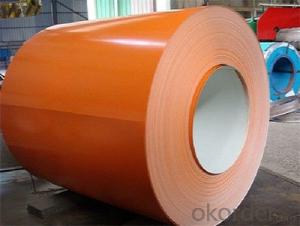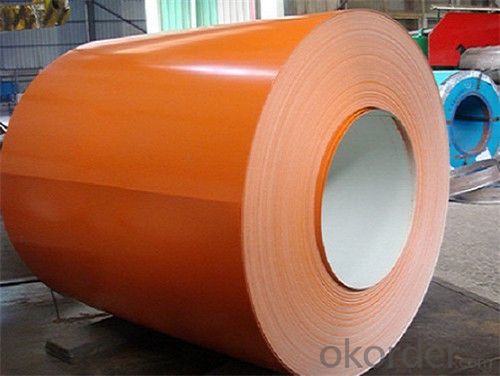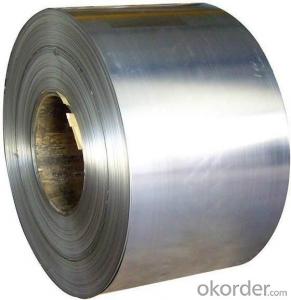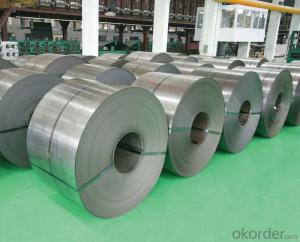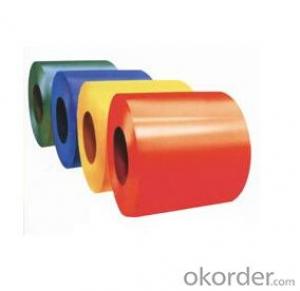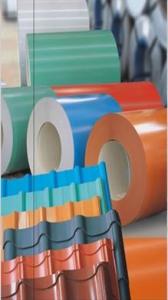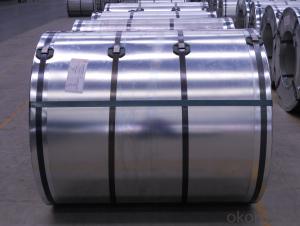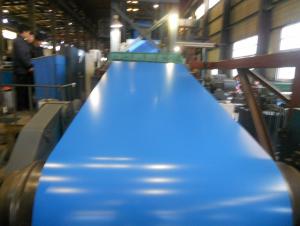color Coated Galvanized cold Rolled Steel Coil
- Loading Port:
- Tianjin
- Payment Terms:
- TT OR LC
- Min Order Qty:
- 25 m.t.
- Supply Capability:
- 300 m.t./month
OKorder Service Pledge
OKorder Financial Service
You Might Also Like
Specification:
1. Standard: HDGI, ALUZINC, CR
2. Grade: SGCC, DX5ID, ASTM, EN10142, S350GD, etc
3. Zinc coating/Aluzinc coating: Z50-200g/ etc m2
4. Package: Export standard package or as per the buyers' requirement
5. Application: Mainly used in the field of roof, outer wall and cabinet, automotive manufacturing, electrical products, locomotives, aviation, precision instrument, canned food, ect
6. Product features:
(1) good durability, and can be used longer than galvanized steel;
(2) has good heat resistance, and compared with galvanized steel, under high temperature it does not discolor easily;
(3) has good heat reflecting
(4) have silvery white luxuriant surface;
(5) has machining capability and spraying performance similar to galvanized steel;
(6) good weldability. Prepainted galvanized steel ppgi corrugated roof sheet
Application Area:
Building exterior, Building interior, Furniture, Household appliances, Steel windows, Panels, Garage doors, etc...
Superiority
1. Good adhesion, can be roll forming
2. The prepainted galvanized steel ppgi corrugated roof sheet color not change even after being roasted under high temperture for 6-12 years
3. Process: Continuous coil coating line --- 3 coating and 3 bake
4. Protective film can be added
Export standard:
Prepainted galvanized steel ppgi corrugated roof sheet 4 eye bands and 4 circumferential bands in steel, galvanized metal and waterproof paper around circumference and bore protection.
| Low-carbon steel | |||||||||
| Base metal | Steel grade | Chemical constitution (heat analysis) % | |||||||
| C | St | Mn | P | S | Alt | Ti | Nb | ||
| Less than | Less than | Less than | Less than | Less than | Less than | Less than | Less than | ||
| Cold rolled base metal | DC51D+Z,DC51D+ZF St01Z, St02Z, St03Z | 0.10 | - | 0.60 | 0.035 | 0.005 | - | - | - |
| DC52D+Z(St04ZR), DC52D+ZF | 0.08 | - | 0.45 | 0.030 | 0.030 | - | - | - | |
| DC53D+Z(St05ZR), DC53D+ZF | 0.08 | - | 0.40 | 0.030 | 0.030 | - | - | - | |
| DC54D+Z(St06ZR), DC54D+ZF | 0.01 | 0.10 | 0.30 | 0.025 | 0.020 | 0.015 | 0.10 | - | |
| DC56D+Z(St07ZR), DC56D+ZF | 0.01 | 0.10 | 0.30 | 0.025 | 0.020 | 0.015 | 0.10 | 0.10 | |
| Hot rolled base metal | DD51D+Z(St01ZR), St(02ZR) | 0.10 | - | 0.50 | 0.035 | 0.035 | - | - | - |
| DD54D+Z(St06ZR) | 0.01 | 0.10 | 0.30 | 0.025 | 0.020 | 0.015 | 0.10 | 0.10 | |
- Q: Whats the difference in composition? When LTCS is used generally?Whats the temperature range, that these materials can be used? Is there any relation between Killed carbon steel, LTCS, stainless steel, carbon steel(normal)? How to categorise/classify these?Thankyou very much in advance..
- When exposed to elevated temperatures, quenched and tempered steels are more susceptible than normalized steels to permanent reduction in strength. This is especially true when exposure temperature begins to approach tempering temperature used when the parts were produced. In addition to losing strength, tempered steels also may experience reduced impact toughness after being exposed to long-term elevated temperatures. General belief is that this is the reason for LCC's reduced maximum allowable temperature limit of 345°C / 650°F in B16.34.
- Q: What is the weight of a standard steel coil?
- The weight of a standard steel coil can vary depending on its dimensions and thickness. However, a typical standard steel coil can weigh anywhere between 3 to 25 tons.
- Q: Aluminum and Steel brittle or ductile based on these results? and why? Steel Aluminium% Elongation 0.2510.2705Modulus of E in ksi11833.33964.71Tensile Strength (ksi)87.5 51.5Yield Strength (ksi)78.5 41
- Only steel(of this pair)might be liable to brittle fracture,which would be implied by almost zero elongation or reduction in area at fracture.On this basis the steel has not failed by brittle fracture.I would expect much more elongation in pure aluminium than your sample shows so I presume it to be brittle unless it is an alloy rather than commercially pure aluminium.However brittle fracture in metals is a particular phenomenon to be determined by impact tests and examination of fracture surfaces and is particularly relevant to metals with the body centred crystal structure.
- Q: so I am trying to drill holes in stainless steel shelving to hang something but my drill wont make any more than a small dent in the steel. I bought a bit for hard metals but it didn't do any better. I have an admittedly small drill (9.6v). is that the problem? do I just need a more powerful drill? any serious advice is appreciated. thanks
- I've had a similar experience attempting to drill heavy steel. Most stainless steel formulations are even harder than mild steel. First, you will need a much more powerful drill. A 9.6v cordless is just not going to do the job. You will want a large corded drill - I'd recommend a half-inch bit chuck. If possible, use a drill press - they typically house very powerful drills, and make holding and aligning the drill much easier. Second, you will need a very, very hard bit. Carbide-tipped is critical. Third, you will need a good deal of patience, depending on the thickness of the steel. Good luck.
- Q: This problem has puzzled me for a long time i always think about why stranded people on islands cant make a proper civilization and i always think it comes down to the ability to work metal. But its not like they could make a steel smelter/furnace out of sand...they would need an older one to use to make the new one...where the hell did the first one come from then????
- You don't need steel to make a smelter. Early ones were made of simple materials such as stone (though the first ones developed would be to smelt gold, then bronze, then iron-widespread use of steel is a relatively late innovation) A desert island resident however would be unlikely to have the skills, nor the iron ore to make one.
- Q: What are the different types of steel coil loading and unloading methods?
- There are several different types of steel coil loading and unloading methods, including overhead crane loading and unloading, forklift loading and unloading, coil car loading and unloading, and conveyor loading and unloading. Each method has its own advantages and suitability depending on the specific requirements and constraints of the steel coil handling process.
- Q: What is the weight range of steel coils?
- The weight range of steel coils can vary greatly depending on the specific type and dimensions of the coil. However, typically, steel coils can weigh anywhere from a few hundred kilograms to several tonnes.
- Q: How are steel coils used in the production of electronic devices?
- Steel coils are used in the production of electronic devices in a variety of ways. One common use is in the manufacturing of transformers and inductors, which are crucial components in many electronic devices. Transformers and inductors consist of a coil of wire wound around a core, and steel coils are often used as the core material due to their magnetic properties. The steel coils used in these components help to enhance the magnetic fields generated by the coils, enabling efficient energy transfer and voltage regulation. The magnetic properties of steel, such as its high permeability and low hysteresis loss, make it an ideal material for these applications. Additionally, steel coils are also used in the production of printed circuit boards (PCBs). PCBs are the backbone of most electronic devices and consist of a flat board made of non-conductive material, such as fiberglass, with a thin layer of copper traces etched onto it. These copper traces form the electrical connections between various components on the board. Steel coils are used in the production of PCBs as part of the fabrication process. They are typically used to create the stencils that are used to apply solder paste onto the board before component placement. The steel coils are laser-cut to create precise stencil patterns, allowing for accurate and consistent solder paste application. In summary, steel coils play a vital role in the production of electronic devices. They are used in the manufacturing of transformers and inductors, where their magnetic properties enhance energy transfer and voltage regulation. Steel coils are also utilized in the fabrication of PCBs, where they are used to create stencils for solder paste application. Overall, the use of steel coils helps ensure the efficient and reliable operation of electronic devices.
- Q: What are the different types of steel coil finishes?
- There are several different types of steel coil finishes, including mill finish, galvanized finish, painted finish, and stainless steel finish.
- Q: Are steel coils susceptible to damage during storage or transportation?
- Yes, steel coils are susceptible to damage during storage or transportation. Steel coils are often heavy and can be prone to deformation, bending, and scratching if mishandled. Additionally, improper stacking or securing during transportation can lead to shifting or movement of the coils, which can cause damage. Furthermore, exposure to moisture, extreme temperatures, or corrosive substances can also affect the integrity of the steel coils. Therefore, it is crucial to handle, store, and transport steel coils carefully to minimize the risk of damage and ensure their quality and usability.
Send your message to us
color Coated Galvanized cold Rolled Steel Coil
- Loading Port:
- Tianjin
- Payment Terms:
- TT OR LC
- Min Order Qty:
- 25 m.t.
- Supply Capability:
- 300 m.t./month
OKorder Service Pledge
OKorder Financial Service
Similar products
Hot products
Hot Searches
Related keywords
